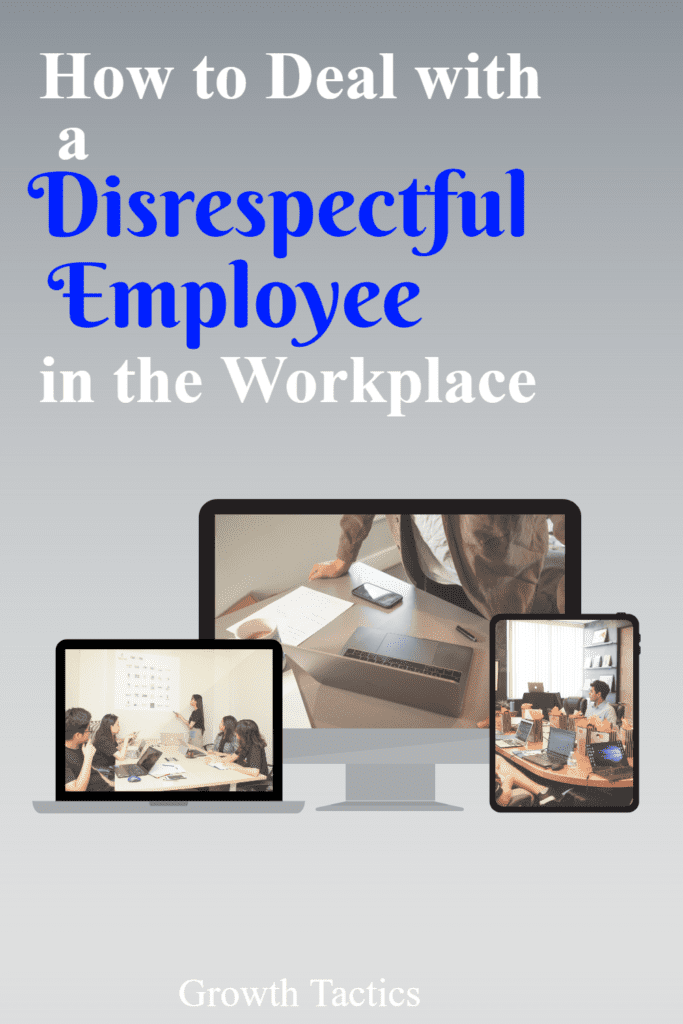Dealing with a disrespectful employee can be a challenging and delicate task. Disrespectful behavior not only affects the individual employee, but can also harm team morale, productivity, and the overall work environment.
To effectively handle a disrespectful employee, it is important to recognize and address the behavior promptly and appropriately. This blog post will provide you with practical tips and strategies on how to handle a disrespectful employee in the workplace. By following these steps and creating a culture of respect, you can foster a positive work environment and maintain a healthy and productive team dynamic.

Jump To Section
1. Recognizing Disrespectful Behavior in the Workplace
The first step in dealing with a disrespectful employee is to be able to recognize and identify disrespectful behavior in the workplace. Disrespectful behavior can manifest in various forms, such as:
Rude or Offensive Language
This can include using profanity, derogatory remarks, or insulting language towards colleagues or superiors.
Belittling or Derogatory Comments
Disrespectful behavior can also involve making demeaning or derogatory comments about someone’s appearance, abilities, or ideas.
Ignoring or Interrupting Others
Disrespectful behavior may involve constantly ignoring or interrupting others during meetings or conversations, showing a lack of respect for their opinions or contributions.
Failure to Follow Company Policies or Guidelines
Employees who consistently disregard company policies or guidelines may demonstrate disrespectful behavior towards authority and create a negative work environment.
Creating a Hostile Work Environment
Disrespectful behavior can create a hostile work environment by engaging in bullying, harassment, or discriminatory actions that make others feel uncomfortable or unsafe.
To address disrespectful behavior effectively, it is essential to establish a culture of respect in the workplace. This can be achieved by:
Addressing Disrespectful Incidents Promptly
Address disrespectful incidents promptly when they occur to prevent them from escalating. Ignoring or downplaying disrespectful behavior can lead to a toxic work environment.
By recognizing and addressing disrespectful behavior, you can establish a foundation for a respectful and professional workplace culture. This will contribute to a more harmonious and productive work environment.
2. Documenting Disrespectful Behavior
When dealing with a disrespectful employee, it’s important to document any incidents of disrespectful behavior. This documentation can serve as evidence of the employee’s behavior and can be used when taking disciplinary action or addressing the issue with HR or upper management. It’s important to include specific details of each incident, such as the date, time, location, and individuals involved.
By documenting disrespectful behavior, you can also demonstrate the impact it has on the workplace. This can help management understand the seriousness of the issue and take appropriate action. Additionally, documenting disrespectful behavior can also serve as a reference for future conversations with the employee, allowing you to track any patterns or repeated incidents.
3. Addressing Disrespectful Behavior with the Employee
When confronted with disrespectful behavior from an employee, it’s crucial to address the issue directly and effectively. Here are some steps to follow when addressing disrespectful behavior with the employee:
Approach the Conversation in a Calm and Professional Manner
Schedule a private meeting with the employee to discuss the issue. Approach the conversation in a calm and composed manner to avoid escalating emotions. Create a safe space where both parties can openly communicate their concerns.
Express Your Concerns and Provide Specific Examples
Clearly express your concerns about the employee’s disrespectful behavior. Use specific examples and incidents to highlight the behavior that is considered disrespectful. This helps the employee understand the impact their actions have on others.
Use “I” Statements and Allow the Employee to Share Their Perspective
When discussing the issue, use “I” statements to express how the behavior affects you or others. For example, instead of saying, “You are always rude to your colleagues,” say, “I have noticed that some of your comments have been disrespectful, which makes me and others feel uncomfortable.” This approach avoids sounding accusatory and encourages the employee to share their perspective.
Make it Clear that the Behavior is Unacceptable
While having the conversation, it’s essential to emphasize that disrespectful behavior is unacceptable in the workplace. Communicate the expectations for behavior and emphasize the importance of maintaining a positive and respectful work environment.
Discuss the Impact of Disrespectful Behavior
It’s important to highlight the impact that disrespectful behavior has on team morale, productivity, and the overall work environment. Explain how such behavior affects collaboration, communication, and the ability to work effectively as a team. Painting a clear picture of the consequences of disrespectful behavior can help the employee understand the gravity of the situation.
Offer the Employee a Chance to Improve
Provide the employee with an opportunity to improve their behavior before considering disciplinary action. Give them clear expectations and guidelines for more respectful behavior. Offer support and guidance if necessary, such as recommending training or resources to help them develop better interpersonal skills.
By addressing disrespectful behavior directly and effectively, you can encourage the employee to reflect on their actions and make positive changes. This approach helps foster a more respectful work environment while allowing the employee to grow and improve.
4. Taking Disciplinary Action
When an employee’s disrespectful behavior persists despite previous attempts to address the issue, disciplinary action may be necessary. Here are some steps to consider when taking action:
Consult HR or Upper Management
Before implementing any disciplinary measures, consult with HR or upper management to ensure that you are following the company’s policies and procedures for handling disrespectful employees. They can provide guidance on the appropriate course of action and ensure that the disciplinary measures align with legal requirements.
Determine the Appropriate Disciplinary Action
Assess the severity and frequency of the disrespectful behavior to determine the appropriate disciplinary action. In less severe cases, verbal or written warnings may suffice. For more serious or repeated instances of disrespect, suspension or termination may be warranted. The disciplinary action should be proportionate to the offense.
Clearly Communicate Consequences
When implementing disciplinary action, clearly communicate the consequences of continued disrespectful behavior to the employee. Explain how their behavior is negatively impacting the workplace and the potential implications if the behavior persists. This helps the employee understand the seriousness of the situation and the importance of correcting their behavior.
Provide an Opportunity for Improvement
Even when taking disciplinary action, it’s important to provide the employee with an opportunity to improve their behavior. Clearly outline the expected changes and give them a chance to make amends. Offer support, additional training, or resources that can help them develop better interpersonal skills and professionalism.
Document the Disciplinary Measures
Keep a detailed record of the disciplinary action taken, including dates, descriptions of the behavior, and any warnings or consequences given. This documentation is crucial for maintaining a record of the actions taken and can serve as evidence in case further action is needed down the line.
Monitor and Follow Up
Continuously monitor the employee’s behavior and provide feedback on their progress. Regularly follow up with them to assess whether the improvements have been made and to address any concerns or issues that may arise. This demonstrates a commitment to creating a respectful work environment and ensures that the employee understands that their behavior is being monitored.
Disciplinary action should always be approached with fairness, consistency, and a focus on corrective measures. By taking appropriate disciplinary action, you can reinforce the importance of respectful behavior and maintain a positive work culture for all employees.
5. Creating a Culture of Respect and Addressing the Work Environment
In order to prevent disrespectful behavior in the workplace, it is essential to establish a culture of respect. This can be achieved through the following steps:
Model Respectful Behavior
As a leader or manager, it is important to model respectful behavior yourself. Treat all employees with respect, dignity, fairness, and professionalism. Show empathy, actively listen to others, and be open to different perspectives.
Educate Employees on Respectful Behavior
Conduct workshops or training sessions to educate employees about what constitutes respectful behavior in the workplace. Provide clear guidelines and expectations for how employees should interact with one another. This can help create a shared understanding of what is acceptable and what is not.
Encourage Open Communication
Promote an environment where open communication is encouraged and valued. Employees should feel comfortable expressing their concerns or grievances without fear of retaliation. Provide channels for anonymous feedback or suggestions to ensure that everyone has a voice and feels heard.
Foster Collaboration and Teamwork
Create opportunities for employees to collaborate and work as a team. Encouraging teamwork helps develop mutual respect and fosters a positive work environment. Team-building activities and projects that involve cross-functional teams can also contribute to a culture of respect.
Address Underlying Issues
It is crucial to address any underlying issues in the workplace that may contribute to disrespectful behavior. Identify specific individuals, teams, or situations that may be causing tension or creating a toxic work environment. Implement effective conflict resolution strategies to address these issues promptly and effectively.
Encourage Reporting and Support
Establish a reporting system for employees to report instances of disrespectful behavior. Assure employees that their concerns will be taken seriously and that there will be no retaliation for reporting. Provide support to employees who have experienced disrespectful behavior, and ensure that appropriate measures are taken to address the issue.
By creating a culture of respect and addressing underlying issues, you can foster a healthy workplace environment where disrespectful behavior is less likely to occur. This enables employees to thrive and work collaboratively, leading to increased productivity and job satisfaction.
6. Providing Support and Training for Employees
In some cases, employees may engage in disrespectful behavior due to a lack of awareness or poor communication skills. Providing support and training for employees can help them to improve their behavior and develop better interpersonal skills. This can include workshops or seminars on effective communication, conflict resolution, and team building.
By helping employees develop these skills, you can improve overall team dynamics and create a more respectful workplace. It’s important to address disrespectful behavior early on and provide employees with the resources they need to make positive changes.
7. Seeking Assistance from HR or Management
If you are unsure how to handle a disrespectful employee or if the behavior persists despite your efforts to address it, it may be necessary to seek assistance from HR or upper management. They can provide guidance on how to proceed, offer additional training or resources, or determine if further disciplinary action is necessary.
It’s important to remember that addressing disrespectful behavior is not only about the individual employee but also about maintaining a positive work environment for the entire team. Taking prompt and appropriate action is crucial to prevent further negative impacts on team morale and productivity.
Conclusion
Dealing with a disrespectful employee in the workplace can be challenging, but it’s important to address the issue promptly and effectively. By recognizing and documenting disrespectful behavior, addressing it with the employee calmly and professionally, and taking appropriate disciplinary action when necessary, you can create a respectful and productive work environment.
Additionally, by creating a culture of respect, providing support and training for employees, and seeking assistance from HR or management when needed, you can prevent disrespectful behavior and maintain a positive workplace culture.
I hope you enjoyed our article on how to deal with a disrespectful employee in the workplace. Please don’t forget to share and subscribe.


